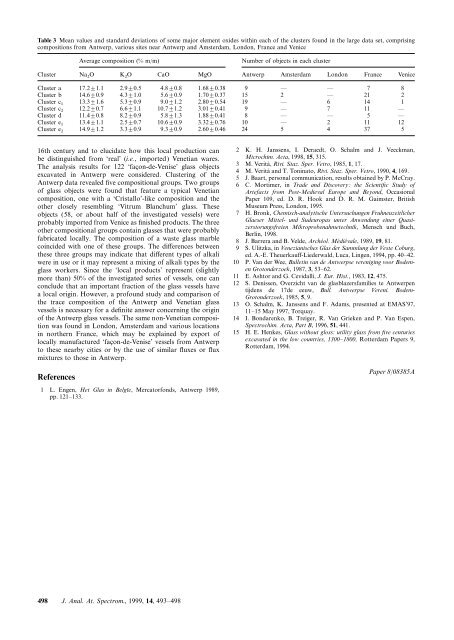Compositional distinctions between 16th century 'façon-de-Venise ...
Compositional distinctions between 16th century 'façon-de-Venise ...
Compositional distinctions between 16th century 'façon-de-Venise ...
Create successful ePaper yourself
Turn your PDF publications into a flip-book with our unique Google optimized e-Paper software.
Table 3 Mean values and standard <strong>de</strong>viations of some major element oxi<strong>de</strong>s within each of the clusters found in the large data set, comprising<br />
compositions from Antwerp, various sites near Antwerp and Amsterdam, London, France and Venice<br />
Average composition (% m/m) Number of objects in each cluster<br />
Cluster Na 2 O K 2 O CaO MgO Antwerp Amsterdam London France Venice<br />
Cluster a 17.2±1.1 2.9±0.5 4.8±0.8 1.68±0.38 9 — — 7 8<br />
Cluster b 14.6±0.9 4.3±1.0 5.6±0.9 1.70±0.37 15 2 — 21 2<br />
Cluster c<br />
1<br />
Cluster c<br />
2<br />
Cluster d<br />
13.3±1.6<br />
12.2±0.7<br />
11.4±0.8<br />
5.3±0.9<br />
6.6±1.1<br />
8.2±0.9<br />
9.0±1.2<br />
10.7±1.2<br />
5.8±1.3<br />
2.80±0.54<br />
3.01±0.41<br />
1.88±0.41<br />
19<br />
9<br />
8<br />
—<br />
—<br />
—<br />
6<br />
7<br />
—<br />
14<br />
11<br />
5<br />
1<br />
—<br />
—<br />
Cluster e<br />
1<br />
Cluster e<br />
2<br />
13.4±1.1<br />
14.9±1.2<br />
2.5±0.7<br />
3.3±0.9<br />
10.6±0.9<br />
9.3±0.9<br />
3.32±0.76<br />
2.60±0.46<br />
10<br />
24<br />
—<br />
5<br />
2<br />
4<br />
11<br />
37<br />
12<br />
5<br />
<strong>16th</strong> <strong>century</strong> and to elucidate how this local production can 2 K. H. Janssens, I. Deraedt, O. Schalm and J. Veeckman,<br />
be distinguished from ‘real’ (i.e., imported) Venetian wares.<br />
The analysis results for 122 ‘façon-<strong>de</strong>-<strong>Venise</strong>’ glass objects<br />
excavated in Antwerp were consi<strong>de</strong>red. Clustering of the<br />
Antwerp data revealed five compositional groups. Two groups<br />
of glass objects were found that feature a typical Venetian<br />
3<br />
4<br />
5<br />
6<br />
Microchim. Acta, 1998, 15, 315.<br />
M. Verità, Rivi. Staz. Sper. Vetro, 1985, 1, 17.<br />
M. Verità and T. Toninato, Rivi. Staz. Sper. Vetro, 1990, 4, 169.<br />
J. Baart, personal communication, results obtained by P. McCray.<br />
C. Mortimer, in Tra<strong>de</strong> and Discovery: the Scientific Study of<br />
Artefacts from Post-Medieval Europe and Beyond, Occasional<br />
composition, one with a ‘Cristallo’-like composition and the Paper 109, ed. D. R. Hook and D. R. M. Gaimster, British<br />
other closely resembling ‘Vitrum Blanchum’ glass. These Museum Press, London, 1995.<br />
objects (58, or about half of the investigated vessels) were<br />
probably imported from Venice as finished products. The three<br />
other compositional groups contain glasses that were probably<br />
fabricated locally. The composition of a waste glass marble<br />
coinci<strong>de</strong>d with one of these groups. The differences <strong>between</strong><br />
these three groups may indicate that different types of alkali<br />
7<br />
8<br />
9<br />
H. Bronk, Chemisch-analytische Untersuchungen Fruhneuzeitlicher<br />
Glaeser Mittel- und Su<strong>de</strong>uropas unter Anwendung einer Quasi-<br />
zerstorungsfreien Mikroprobenahmetechnik, Mensch und Buch,<br />
Berlin, 1998.<br />
J. Barrera and B. Vel<strong>de</strong>, Archéol. Médiévale, 1989, 19, 81.<br />
S. Ulitzka, in Venezianisches Glas <strong>de</strong>r Sammlung <strong>de</strong>r Veste Coburg,<br />
ed. A.-E. Theuerkauff-Lie<strong>de</strong>rwald, Luca, Lingen, 1994, pp. 40–42.<br />
were in use or it may represent a mixing of alkali types by the 10 P. Van <strong>de</strong>r Wee, Bulletin van <strong>de</strong> Antwerpse vereniging voor Bo<strong>de</strong>m-<br />
glass workers. Since the ‘local products’ represent (slightly en Groton<strong>de</strong>rzoek, 1987, 3, 53–62.<br />
more than) 50% of the investigated series of vessels, one can<br />
conclu<strong>de</strong> that an important fraction of the glass vessels have<br />
a local origin. However, a profound study and comparison of<br />
the trace composition of the Antwerp and Venetian glass<br />
vessels is necessary for a <strong>de</strong>finite answer concerning the origin<br />
11<br />
12<br />
13<br />
E. Ashtor and G. Cevidalli, J. Eur. Hist., 1983, 12, 475.<br />
S. Denissen, Overzicht van <strong>de</strong> glasblazersfamilies te Antwerpen<br />
tij<strong>de</strong>ns <strong>de</strong> 17<strong>de</strong> eeuw, Bull. Antwerpse Vereni. Bo<strong>de</strong>m-<br />
Groton<strong>de</strong>rzoek, 1985, 5,9.<br />
O. Schalm, K. Janssens and F. Adams, presented at EMAS’97,<br />
11–15 May 1997, Torquay.<br />
of the Antwerp glass vessels. The same non-Venetian composi- 14 I. Bondarenko, B. Treiger, R. Van Grieken and P. Van Espen,<br />
tion was found in London, Amsterdam and various locations Spectrochim. Acta, Part B, 1996, 51, 441.<br />
in northern France, which may be explained by export of<br />
locally manufactured ‘façon-<strong>de</strong>-<strong>Venise</strong>’ vessels from Antwerp<br />
to these nearby cities or by the use of similar fluxes or flux<br />
mixtures to those in Antwerp.<br />
15 H. E. Henkes, Glass without gloss: utility glass from five centuries<br />
excavated in the low countries, 1300–1800, Rotterdam Papers 9,<br />
Rotterdam, 1994.<br />
References<br />
1 L. Engen, Het Glas in Belgïe, Mercatorfonds, Antwerp 1989,<br />
pp. 121–133.<br />
498 J. Anal. At. Spectrom., 1999, 14, 493–498<br />
Paper 8/08385A
















